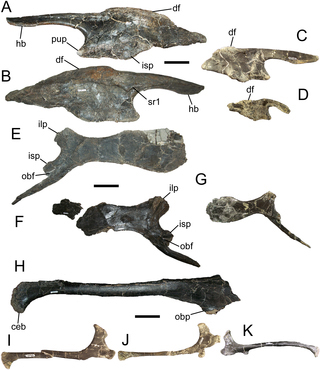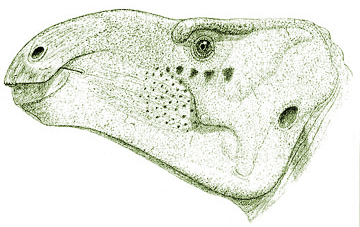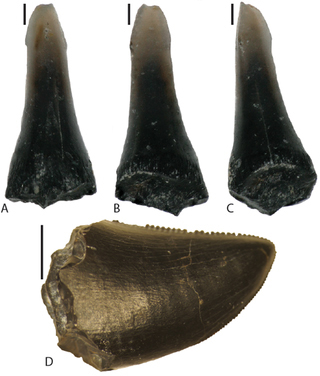Thumbing Through the Iguanodontia
Sorting Out Eolambia caroljonesa
The Cedar Mountain Formation of the western United States has yielded a number of important dinosaur discoveries, helping to map the megafauna of America during the Cretaceous. Iconic dinosaurs such as the armoured herbivore Gastonia and the “raptors” Deinonychus and Utahraptor are known from the various members that make up the Cedar Mountain Formation. However, the most abundant dinosaurs in terms of the genera named are ornithopods and a team of scientists including researchers from the Field Museum (Chicago), have published a new paper helping to identify where, in the dinosaur family tree, one ornithopod – Eolambia caroljonesa should be placed.
An Ornithopod Dinosaur Riddle
The youngest member of the Cedar Mountain Formation (a member being a distinct, identifiable portion of a rock formation that can be identified as a stratigraphic unit), is the Mussentuchit Member and the most common dinosaur fossils associated with these strata relate to Eolambia caroljonesa.
This herbivorous dinosaur is known from quite extensive fossils including skull material and three bonebeds that contain the jumbled up remains of a number of juveniles. Named by the famous American palaeontologist James Kirkland in 1998, Eolambia means “early or dawn Lambeosaur”, reflecting the proposed taxonomic position of this dinosaur as being a basal member of the lambeosaurines (crested duck-billed dinosaurs).
Eolambia caroljonesa
Over the last two decades, since the discovery and naming of Eolambia, many more iguanodontian dinosaurs have been named. This has helped palaeontologists to better understand the evolution of ornithopods from the non-hadrosaurid forms known from the Early Cretaceous to the duck-billed dinosaurs which were prevalent during the Campanian to Maastrichtian faunal stages of the Cretaceous (Late Cretaceous).
Writing in the on-line academic journal PLOS One, the researchers describe some further postcranial remains of Eolambia from the Mussentuchit Member. The fossils represent a sub-adult animal and as a result, these bones are more helpful when it comes to establishing autapomorphies (unique features), that help to establish where in the dinosaur family tree Eolambia should be nested.
The Eolambia Postcranial Fossils Laid Out in an Approximate Life Position
Picture credit: PLOS One with additional annotation by Everything Dinosaur
Calculating the Size of Eolambia caroljonesa
The picture above shows the newly described postcranial fossil material laid out in approximate skeletal position, using the better known iguanodontid Mantellisaurus atherfieldensis as a template. The scale bar equals one metre. One of the outcomes of this new study is that the research team will be able to provide a better estimate of the true size of Eolambia.
When first named by Kirkland, this dinosaur was estimated to be around eight to nine metres in length.
However, Gregory S. Paul (2010), suggested that Eolambia was considerably smaller with a total body length of around six metres. Having to rely on juvenile material makes estimating the adult size of a dinosaur very difficult. The ilium (number 26 in the picture above), measures a fraction under seventy-one centimetres in length. Everything Dinosaur team members have examined their data files and compared this measurement to the size of ilia from other iguanodontids. For example, the ilium of the Spanish iguanodontid Delapparentia turolensis measures seventy-eight centimetres long. As Delapparentia is estimated to have been up to ten metres in length, it is likely that a fully-grown Eolambia could perhaps measure around nine metres from nose to tail.
Comparing Eolambia Pelvic Material (E. caroljonesa)
Picture credit: PLOS One
The picture above shows the sub-adult pelvic material representing the new specimen FMNH PR 3847 (A, B, E, F, H and K) compared to other known fossil material including juvenile remains (C, D, G, I and J). The scale bar equals ten centimetres. Histological analysis from a sample of rib bone indicates that this dinosaur was between eight to nine years of age when it died.
Eolambia in the Dinosaur Family Tree
Specimen FMNH PR 3847 provides new anatomical detail regarding the back bone and pelvic girdle of E. caroljonesa. As the fossils come from a sub-adult, the scientists have been more confident in the phylogenetic assessment of where within the Ornithopoda Eolambia should be nested. The researchers conclude that this dinosaur was only very distantly related to the lambeosaurines and that it was a basal hadrosauromorph closely related to Protohadros byrdi, fossils of which come from similarly aged rocks (Cenomanian faunal stage), from Texas (Woodbine Formation).
An Illustration of Eolambia
Signs of a Predatory Dinosaur
The fossils were deposited in strata that was formed in a crevasse splay feature – sediment deposited when a stream breaks its banks and deposits sediment on the flood plan. Along with the dinosaur bones the scientists identified a large number of crocodylomorph teeth and small bones and a tooth from a gar (fish). Intriguingly, the team also found broken teeth from a large, meat-eating dinosaur. Although, the exact taxon cannot be pinned down, the scientists postulate that these teeth could have come from Siats meekerorum, an apex predator known from similar aged strata in Utah.
Teeth Found in Association with the Eolambia Material
Picture credit: PLOS One
The scale bar for the single gar tooth (several views) is 0.2 centimetres, the scale bar for the theropod tooth is 0.5 centimetres.
The Eolambia species name honours Carole Jones who, along with her husband Ramal Jones, discovered the fossil site from which the first fossils of this dinosaur including the holotype material was collected.
For dinosaur models and prehistoric animal replicas: Dinosaur and Prehistoric Animal Models.





